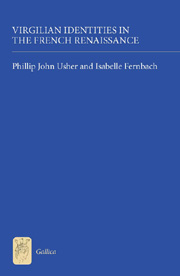Book contents
- Frontmatter
- Contents
- List of Illustrations
- Dedication
- Foreword
- List of Contributors
- Acknowledgements
- Note on Editions and Translations
- Introduction
- Part I Pastoral and Georgic Modes
- 1 Virgil and Marot: Imitation, Satire and Personal Identity
- 2 Virgil's Bucolic Legacy in Jacques Yver's Le Printemps d'Yver
- 3 On the Magical statues in lemaire de Belges's Le Temple d'honneur et de vertus
- 4 Temples of Virtue: Worshipping Virgil in Sixteenth-Century France
- 5 From Copy to Copia: Imitation and Authorship in Joachim Du Bellay's Divers Jeux Rustiques (1558)
- Part II The Epic Mode
- Index
- Already Published
3 - On the Magical statues in lemaire de Belges's Le Temple d'honneur et de vertus
from Part I - Pastoral and Georgic Modes
Published online by Cambridge University Press: 05 February 2013
- Frontmatter
- Contents
- List of Illustrations
- Dedication
- Foreword
- List of Contributors
- Acknowledgements
- Note on Editions and Translations
- Introduction
- Part I Pastoral and Georgic Modes
- 1 Virgil and Marot: Imitation, Satire and Personal Identity
- 2 Virgil's Bucolic Legacy in Jacques Yver's Le Printemps d'Yver
- 3 On the Magical statues in lemaire de Belges's Le Temple d'honneur et de vertus
- 4 Temples of Virtue: Worshipping Virgil in Sixteenth-Century France
- 5 From Copy to Copia: Imitation and Authorship in Joachim Du Bellay's Divers Jeux Rustiques (1558)
- Part II The Epic Mode
- Index
- Already Published
Summary
The Virgilian origins of Jean Lemaire de Belges's Le Temple d'honneur et de vertus (1503) are obvious. Throughout the poem, shepherds, whose literary configuration is strongly influenced by Virgil's Eclogues, proclaim the glories of a politically powerful person, the recently deceased Pierre II de Bourbon. However, another less obvious Virgilian connection might also be seen in this poem. Like Joachim Du Bellay's Chant triumphal sur le voyage de Boulongne (1549), and Pierre de Ronsard's Le Temple de Messeigneurs le connestable, et des chastillons (1573), Lemaire's Temple describes an edifice that contains statues and images that that are used to symbolize the virtues of an eminent person in ways that are highly redolent of another Virgilian source: the temple and statues that Virgil describes in the proem to his third Georgic. The differences are significant nonetheless. Whereas in Du Bellay and Ronsard the statues are described as being “life-like,” in Lemaire's Temple these statues actually come to life. The political and poetic function of the poem is radically altered: political greatness is not represented through mimesis but through prophetic discourse and metaphysical participation. The living statues enunciate the virtues they represent symbolically in the other poems, and participate in transcendent glory, just as the subject of the poem, Pierre II de Bourbon, is understood to have done.
- Type
- Chapter
- Information
- Virgilian Identities in the French Renaissance , pp. 59 - 72Publisher: Boydell & BrewerPrint publication year: 2012



